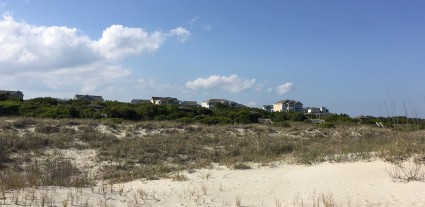Last in a two-part series
HOLDEN BEACH – What if the answer is an emphatic “no”?
Supporter Spotlight

That response from a private land owner to a municipality seeking certain property rights for the purpose of building a terminal groin could halt the necessary permitting process by months, even years.
Army Corps of Engineers regulations do not require the proof of real property ownership, according to Carl Pruitt, assistant district counsel in the Corps’ Wilmington District. A dredge-and-fill permit from the Corps is needed for projects in navigable waters.
However, when an applicant signs a Department of the Army, or DA, application, “the applicant affirms that they have, or will have, sufficient rights to complete the project,” Pruitt wrote in an email. “If the applicant never gets a sufficient interest, they may potentially have a DA permit, but be unable to do the work because they do not have a sufficient real estate interest.”
Proof of Ownership
Major permits under the N.C. Division of Coastal Management’s Coastal Area Management Act on the other hand require applicants to include a copy of the deed or other document showing title to land.
This means that beach communities that want to build terminal groins will have to either get permission from private property owners through easements or force their hand and condemn the properties of those who refuse to sign easements.
Supporter Spotlight
An easement allows the holder of the easement to use property they do not own.
In beach towns, these binding legal agreements are commonly made for beach maintenance, allowing construction crews and equipment onto private properties during sand re-nourishment projects.
Voluntary easements usually come with the warning that, if they are not signed, the municipality will invoke its right to take the property through eminent domain.
Sometimes the outcome goes smoothly for a town. Sometimes it does not.
Voluntary Easements

Thus was the case for Nags Head in 2011 when several beachfront property owners sued the town for seeking voluntary easements for a one-time sand nourishment project across a 10-mile stretch of beach.
Property owners claimed that the voluntary easements the town sought would transfer property rights to the town “over and beyond those necessary” for the project. The property owners argued that their constitutional rights were violated because the town did not offer just compensation for the voluntary easements.
More than a year after the town requested the easements, the N.C. Court of Appeals affirmed an earlier trial court decision that ruled in favor of the town.
Ocean Isle Beach is in the process of obtaining voluntary easements the town needs to complete a CAMA major permit application.
As of May 12, the town had received 34 of the 50 easements mailed to property owners in February, according to Town Administrator Daisy Ivey.
Property owners were asked to return the easements as soon as possible.
Ivey said the town does not anticipate taking property through eminent domain.
Eminent Domain

In general, municipalities try to avoid invoking the power of eminent domain.
“It’s rarely used by municipalities,” said Charles Szypszak, professor of public law and government with the University of North Carolina at Chapel Hill’s School of Government. “They try very hard to avoid using it. It’s not a very political happy thing to do.”
As Holden Beach waits for the release of the final Environmental Impact Statement on its terminal groin project, it remains unclear whether that town will have to obtain easements to private properties at the east end of the island.
Ronda Dixon owns one of two oceanfront lots where the proposed 1,000-foot-long terminal groin may stretch across the sand and into the water.
Dixon and her husband live in the gated community of Dunescape on a sprawling lot where lush, thick green vegetation abuts the sandy spit that has accreted on the eastern tip of the barrier island.
When asked what her response will be if the town requests an easement to her property, Dixon replied, “I think it’s too early to comment.”
“I can’t even anticipate how it will unfold,” she said. “I’ve never been through a process like this before. I am of the opinion that there are many basic reasons for why the terminal groin is not good for Holden Beach and they are economically, environmentally, functionality and safety and liability.”
Holden Beach Mayor Alan Holden said he does not believe the town will have to take land for the project.
“That’s one of the things that is being hashed out as we go forward with the permit process,” he said.
Figure Eight Island
The board of directors of the Figure Eight Island Homeowners Association hopes to get voluntary easements from several property owners at the northern end of the private island.
“Where the actual terminal groin will be placed, if it is on private property, then certainly it is our intent to get an easement from that property owner for the placement and construction of the actual terminal groin,” said David Kellam, the island’s administrator. “We have people who are glad to sign an easement because they believe a terminal groin is the right thing to do.”
Property owners said to be holding out on granting easements have declined to be interviewed.
Since the island is unincorporated, the board does not have the legal authority to take the property through condemnation.
Kellam said the board has discussed other options if some of the property owners refuse to grant easements, including “not building it on that stretch, or something of that nature.”
“But we’re certainly looking at every option,” he said. “We have looked at incorporation as well, but not in regards to this. We have just looked at incorporation, period. That’s certainly not our plan. We believe that good science and engineering and good information to the property owners will, in fact, give them a better and complete understanding of what is really occurring out there. The vast majority of our membership looks to us to provide them accurate information.”
The 563-member HOA has not been asked to vote on the proposed project.







